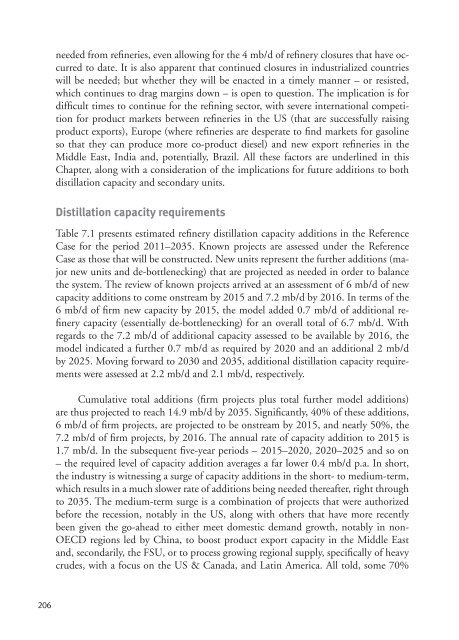World Oil Outlook - Opec
World Oil Outlook - Opec
World Oil Outlook - Opec
- TAGS
- world
- outlook
- opec
- www.opec.org
You also want an ePaper? Increase the reach of your titles
YUMPU automatically turns print PDFs into web optimized ePapers that Google loves.
206<br />
needed from refineries, even allowing for the 4 mb/d of refinery closures that have occurred<br />
to date. It is also apparent that continued closures in industrialized countries<br />
will be needed; but whether they will be enacted in a timely manner – or resisted,<br />
which continues to drag margins down – is open to question. The implication is for<br />
difficult times to continue for the refining sector, with severe international competition<br />
for product markets between refineries in the US (that are successfully raising<br />
product exports), Europe (where refineries are desperate to find markets for gasoline<br />
so that they can produce more co-product diesel) and new export refineries in the<br />
Middle East, India and, potentially, Brazil. All these factors are underlined in this<br />
Chapter, along with a consideration of the implications for future additions to both<br />
distillation capacity and secondary units.<br />
Distillation capacity requirements<br />
Table 7.1 presents estimated refinery distillation capacity additions in the Reference<br />
Case for the period 2011–2035. Known projects are assessed under the Reference<br />
Case as those that will be constructed. New units represent the further additions (major<br />
new units and de-bottlenecking) that are projected as needed in order to balance<br />
the system. The review of known projects arrived at an assessment of 6 mb/d of new<br />
capacity additions to come onstream by 2015 and 7.2 mb/d by 2016. In terms of the<br />
6 mb/d of firm new capacity by 2015, the model added 0.7 mb/d of additional refinery<br />
capacity (essentially de-bottlenecking) for an overall total of 6.7 mb/d. With<br />
regards to the 7.2 mb/d of additional capacity assessed to be available by 2016, the<br />
model indicated a further 0.7 mb/d as required by 2020 and an additional 2 mb/d<br />
by 2025. Moving forward to 2030 and 2035, additional distillation capacity requirements<br />
were assessed at 2.2 mb/d and 2.1 mb/d, respectively.<br />
Cumulative total additions (firm projects plus total further model additions)<br />
are thus projected to reach 14.9 mb/d by 2035. Significantly, 40% of these additions,<br />
6 mb/d of firm projects, are projected to be onstream by 2015, and nearly 50%, the<br />
7.2 mb/d of firm projects, by 2016. The annual rate of capacity addition to 2015 is<br />
1.7 mb/d. In the subsequent five-year periods – 2015–2020, 2020–2025 and so on<br />
– the required level of capacity addition averages a far lower 0.4 mb/d p.a. In short,<br />
the industry is witnessing a surge of capacity additions in the short- to medium-term,<br />
which results in a much slower rate of additions being needed thereafter, right through<br />
to 2035. The medium-term surge is a combination of projects that were authorized<br />
before the recession, notably in the US, along with others that have more recently<br />
been given the go-ahead to either meet domestic demand growth, notably in non-<br />
OECD regions led by China, to boost product export capacity in the Middle East<br />
and, secondarily, the FSU, or to process growing regional supply, specifically of heavy<br />
crudes, with a focus on the US & Canada, and Latin America. All told, some 70%
















